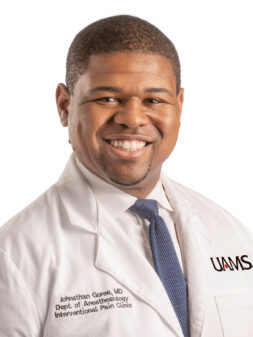Description
Dr. Johnathan H. Goree talks about chronic pain including when to see a doctor and common causes of chronic pain. Acute pain, if not treated, can turn into chronic pain so he encourages patients to listen to their bodies and advocate for themselves. He also discusses some misconceptions patients might have about treatments but how he ultimately helps his patients experience a higher quality of life.
Video Player
Transcript
Kaelin Clay:
Well, September is pain awareness month. It’s a time to reflect on the needs of people with chronic pain. So joining us to raise awareness about pain management is Dr. Johnathan Goree, director of interventional Pain management services at UAMS. Thank you so much for joining us.
Johnathan H. Goree, M.D.:
Thanks for having me. Glad to be here.
Clay:
Now, can you explain the difference between chronic pain and acute pain?
Dr. Goree:
Pain is a part of day-to-day life. It’s really our body’s warning system that something’s wrong. If we sit in an uncomfortable chair, we feel pain. If we stub our toe, we feel pain. Chronic pain is when pain becomes dysfunctional. So after our body heals, if we still have pain, then that classifies as chronic pain. Or if we have an injury and we feel more pain than we normally would, then that’s chronic pain.
Clay:
Now, obviously chronic pain is not the news anyone would want to hear. What are some common causes of chronic pain?
Dr. Goree:
Any reason to have acute pain can unfortunately develop into chronic pain over time. So sometimes it happens from repetitive injuries. If you keep hurting your back over and over again, then that pain can become dysfunctional because your brain gets used to feeling pain, and that pain becomes a part of your day-to-day life. Or if you have any kind of injury or surgery, it’s very common after surgery to develop chronic pain, especially if that pain isn’t treated aggressively upfront.
Clay:
Is it pretty common across the United States and even in Arkansas?
Dr. Goree:
You know, one in five people deal with chronic pain every day. I mean, it’s absolutely amazing. And a lot of that pain is either back pain or neck pain. Unfortunately, people from — especially those who do manual labor, who do construction, you know, those folks who do those down-home really hard jobs, they could really hurt their back over and over again. And then they can develop and become chronic.
Clay:
As you’re having those injuries, how long do you need to wait to report it or how soon do you need to go to a doctor and say, “Hey, this is going on. I think it might be chronic pain.” What’s the timeline for that?
Dr. Goree:
I always tell patients to really listen to their bodies and advocate for themselves. If you have pain that’s at the point where Tylenol and ibuprofen and the things you have at home aren’t working, I think it’s time to see a doctor, whether that’s an urgent care or an emergency room. And then on top of that, if you have pain that lasts longer than six weeks, I would say either talk to your primary care doctor or see a pain specialist like myself and really start to have conversations around like, is your body starting to develop kind of a feedback loop of pain that’s not normal.
Clay:
And when they go to their doctor, when they report that, what are some pain management plans you can help them come up with?
Dr. Goree:
You know, honestly, especially in our clinic, we really focus on quality of life. So we talk to patients about what is your goal, and what are you trying to do. And oftentimes it can be things like playing with their grandkids, going shopping, taking a trip, or taking a family vacation. And if patients aren’t able to do that, then we individualize plans, whether that be medications, whether that be procedural injections to help get them back to their daily lives.
Clay:
Are there any misconceptions about chronic pain?
Dr. Goree:
There always are. You know, the opioid epidemic has been challenging over the past 20 years. And a lot of times we aren’t prescribing the same medicines that we were 20 years ago. And a lot of patients are frustrated by that. And just because we have made strides in the opioid epidemic doesn’t mean that we’ve stopped the pain epidemic, and a lot of patients are really dealing with pain. And so if you work with your doctor and also potentially work with a pain management specialist, we may be able to come up with a plan, a mix of medications and procedures to get you back to your life.
Clay:
What are some of those non-opioid interventions?
Dr. Goree:
One really common one that we do is called ablations. And so our pain is carried to our brain via nerves. I think of nerves as highways from the body to our brain. And so if we disrupt those highways, then we can prevent that pain. We can stop that pain signal from getting to our brain. And so a common treatment for back pain is to do an ablation where you actually disrupt the nerve signal from the back and then get patients back into physical therapy or muscle-strengthening so they can get back to their normal day-to-day life.
Clay:
What other resources are available for people living with chronic pain?
Dr. Goree:
If you go to uams.edu, you can definitely learn about our interventional pain clinic. So pain.uams.edu, we have a lot of resources to teach patients about chronic pain about the different treatments that we have. And if you have more questions, you can come and see us and we can hopefully help you.
Clay:
With September being Pain Awareness Month, how do you encourage people to take this time and think about pain management?
Dr. Goree:
I always tell patients to really listen to their bodies. You know, if you’re ever having pain that’s preventing you from doing the things that you enjoy, then think about having a conversation with a physician. And also think about your family members. If they’re not able to do the things that they’ve always loved to do, if you have a father who always loved to fish or loved to hunt and they just can’t get out and do it anymore, maybe have a conversation with them and have some awareness of the pain that they’re having, and maybe get them over to their physician so that they can hopefully get back to their quality of life.
Clay:
Can chronic pain often be reversed?
Dr. Goree:
It can be reversed. And that’s what we’re really hoping for is, you know, if we’re able to get patients on a treatment plan that really focuses in on their goals, then we can get them back to their day-to-day and we can reverse that chronic pain.
Clay:
Is there anything else you’d like to add today, or about the month, or about treatment plans?
Dr. Goree:
No, thank you for having me. I’m really glad to have this conversation. There are so many patients that are out there who are dealing with chronic pain, and folks like me and other physicians who have dedicated their lives to pain management really just want to help those patients.
Clay:
Definitely nothing anyone wants to deal with. So I’m so glad you came on today to share those tips and talk a little bit more about the subject. Thanks for your time.
Dr. Goree:
Thanks for having me. I appreciate it.



